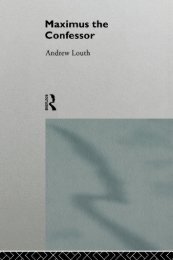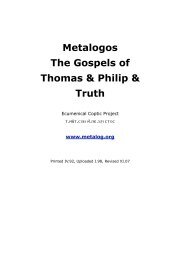Gospels of Thomas and Philip and Truth - Syriac Christian Church
Gospels of Thomas and Philip and Truth - Syriac Christian Church
Gospels of Thomas and Philip and Truth - Syriac Christian Church
Create successful ePaper yourself
Turn your PDF publications into a flip-book with our unique Google optimized e-Paper software.
as the original Gospel Messianics were eventually supplanted by the<br />
Pauline ‘<strong>Christian</strong>s’ (Ac 11:2526). Thus the Epistle <strong>of</strong> Barnabas (late first<br />
century) remains unacquainted with the historical <strong>Gospels</strong>, whereas Justin<br />
Martyr (mid-second century) shows no awareness <strong>of</strong> Paul's writings—<br />
indicating an ongoing schism between the Petrine <strong>and</strong> the Pauline<br />
traditions. Clement <strong>of</strong> Alex<strong>and</strong>ria <strong>and</strong> Irenaeus <strong>of</strong> Lyon, at the end <strong>of</strong> the<br />
second century, are the first authors explicitly to quote from both the<br />
<strong>Gospels</strong> <strong>and</strong> from Paul. I have attempted to analyze the basis <strong>of</strong> this rift<br />
in ‘The Paul Paradox’, Comm.5, below. Essential reading on that formative<br />
period is Walter Bauer's pioneering study, Orthodoxy <strong>and</strong> Heresy in<br />
Earliest <strong>Christian</strong>ity (1934; http://ccat.sas.upenn.edu/humm/Resources/Bauer).<br />
The translations <strong>of</strong> the texts themselves are both as literal <strong>and</strong> as<br />
lyrical as I could make them. Any grammatical irregularities encountered<br />
(e.g. the verb tenses in Th 109) are in the Coptic text itself. Plausible<br />
textual reconstructions are in [brackets], while editorial additions are in<br />
(parentheses). ‘[...]’ indicates places where it is not possible to<br />
interpolate the deterioration <strong>of</strong> the papyrus manuscript. The Greek<br />
Oxyrhynchus variants to <strong>Thomas</strong> are within {braces}. ‘You’ <strong>and</strong> its<br />
cognates are plural, ‘thou’ <strong>and</strong> its cognates represent the singular (but<br />
generally with the modern verb-form). Notes at the end <strong>of</strong> each logion<br />
are indicated by superscript¹, those at the end <strong>of</strong> the current text with a<br />
circle°. The scriptural cross-references listed are essential to an<br />
underst<strong>and</strong>ing <strong>of</strong> the saying in its biblical context, <strong>and</strong> the reader is urged<br />
to refer to them in every case; explicit parallels to <strong>Thomas</strong> in the<br />
Synoptics are separately marked with an equal sign=, to spare the reader<br />
looking up what is already well-known. In antiquity, <strong>of</strong> course, there were<br />
no lower-case letters, <strong>and</strong> thus in order to represent the Hebrew, Greek<br />
<strong>and</strong> Coptic scripts I have not here used their subsequent cursive letters<br />
but rather their classic forms, which are easier for the non-scholar to<br />
read. In turn, in translating such ancient texts to modern languages, it is<br />
virtually impossible to capitalize in a consistent <strong>and</strong> adequate manner; I<br />
7




